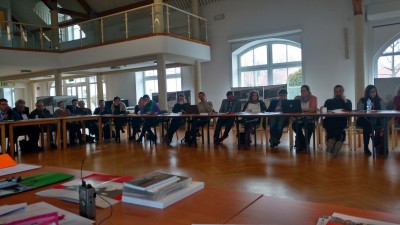This year, the Seminar, traditionally held at the International Meeting Place in Krzyzowa/Kreisau in Lower Silesia, Poland (organised by the Kreisau Foundation, the German Federal Foundation for the Study of Communist Dictatorships (Bundesstiftung Aufarbeitung), the Polish Institute of National Remembrance from Wroclaw, the German War Grave Commission (Volksbund), and the Evangelische Academie Berlin, was devoted to the topic of resistance and collaboration in national remembrance. During the three days of the Seminar, through panel discussions and presentations on different memorialisation approaches to these issues, we dealt with various concepts of resistance and collaboration, the role of resistance and collaboration in different national narratives, and the controversies and difficulties we face when we try to define these concepts in unequivocal terms.

The Seminar was attended by memory researchers and practitioners, museum staff, historians, activists and reporters from Albania, Bosnia and Herzegovina, France, Croatia, Italy, Canada, Lithuania, Hungary, Germany, Poland, Russia, Slovakia and Ukraine. We had the opportunity to hear different perspectives and approaches to these issues, and we from CNA held a workshop on dealing with issues of guilt and responsibility in post-war society.
Traditionally, the concepts of resistance and collaboration are related, or were related to the Second World War. That was when the ethical standard of resistance against Nazism was formed. In that sense, when we talk about resistance movement(s), we are usually dealing with a heroic image of resistance that includes those that were ethically on the right side (also in the sense that they fought against anti-Semitism, such as the Yugoslav, French and Italian resistance movements, and others). However, those who collaborated with the enemy/occupier are considered traitors and were dealt with as such after the Second World War. They are, therefore, largely left out of national narratives as post-war victims and are not a popular topic of discourse.
After the fall of the Berlin Wall and the collapse of Eastern European communist systems, these roles were radically changed in some national narratives and contexts. Who will be remembered as having resisted (the enemy) and who will be remembered as a collaborator will depend on the vantage point in time and the time period under consideration, and therefore, also on who is identified as the enemy within that time period and how this relates to the given national narrative. Namely, the change of political system following 1989 and during the 1990s was a powerful psychological break with the previous political tradition and marked a time when “free people in a free country” could engage in critical discussion of these issues.
Due to changes in the political paradigm, after the 1990s, it became possible to claim that collaboration may denote even a minimal degree of cooperation (such as paying taxes or sending children to school). Speaking about different types of resistance (non-communist resistance, right-wing resistance with anti-Semitic elements, etc.) also became possible. The circumstances under which resistance arose were examined, as well as the extent to which European resistance movements were successful and widespread and how they were subsequently treated within their respective national narratives. The current use of these concepts will largely depend on who is speaking, which is most visible in former communist countries, i.e. the former countries of the Eastern Bloc, where the binary of resistance and collaboration is now also applied to the period of Soviet occupation.

This establishes competition between historical memory and facts, and various memory communities, each of which emphasises or remembers different elements. We had the opportunity to hear about some of these different approaches to remembrance and elements of remembrance in museums, exhibitions and memorial sites through presentations on concrete examples from Italy, Croatia, Hungary, Albania, Canada, France and Russia.
The Seminar also included a visit to the German war cemetery Nadolice Wielkie (Groß Nädlitz), a memorial to some 18 thousand German soldiers killed in the Second World War[1]. German war cemeteries are memorials established for peace, and as places of meeting and reconciliation, says the exhibition set up in the central building of the cemetery where registers of names of those buried at the cemetery and the dates of their identification are kept. The cemetery also includes a Peace Park with over 600 trees bearing a symbolic message – a tree can live to a very old age, but only if we care for it and protect it, only then can it grow and bloom in peace. Anyone who has lived with the consequences of war can easily understand this parallel, says a poster in exhibition at the central building. The Peace Park serves as a reminder that peace must be kept at all costs.
[1] It is estimated that 468 thousand German soldiers were killed in Poland during the Second World War, of which 300 thousand have been officially registered. The number of German civilian casualties has not been determined yet.